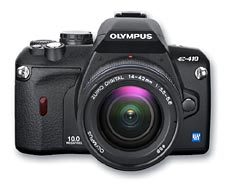The 10-megapixel Olympus E-410 updates the E-400 with a new Live MOS image sensor, and new TruePic III image processor.
Olympus E-410 Review
Features
New Sensor
So what changes has the E-410 brought to the E-System table, and how significant are they? Well, for a start, the newcomer uses a wholly new sensor – a LiveMOS sensor with 10 million effective pixels compared to the 10MP ‘conventional’ CCD in the E-400.
New Image Processor
This has been joined by a new processing engine, and perhaps this is why the E-410 now has an improved burst depth that allows it to record eight Raw frames or unlimited HQ JPEG frames at a rate of three per second. By comparison, the E-400 achieved just five Raw or 10 HQ JPEGs at the same rate and was criticised for a general lack of speed. The inclusion of USB 2.0 Hi-Speed with the E-410 also addresses complaints targeted at the E-400’s humble USB 1.1 connection.
LCD Display
Further improvements can be found when we look at the rear LCD screen, which although still a 2.5in unit has seen its resolution increase to 230,000 pixels (from 215,000 pixels, which admittedly is not a great leap) and now includes Olympus’s live view system that allows you to use the screen to compose your shots as you might with a digital compact. Finally, the power of the flash has been boosted, and what was a decidedly lacklustre flash on the E-400 (with a guide number of only 10) has been replaced by a more respectable unit with a guide number of 12 – a useful power boost that now puts it on a par with rival DSLRs.
Aside from these things – some of which are great steps forwards and others which are more evolutionary advances – the basic photographic features on the E-410 remain the same as those in the E-400, right down to the Supersonic Wave Filter for combating dust on the sensor.
The 10MP sensor allows images to be printed up to 12x9in in size at 300ppi, while Raw and JPEG files can be recorded individually or together and stored on either xD or CompactFlash media thanks to the E-410’s dual card slots.
Metering Options
There’s 49- zone ESP metering to take care of most situations, with centre-weighted and spot patterns on hand when things get a little trickier. There are also the ‘highlight spot’ and ‘shadow spot’ metering modes unique to Olympus cameras, that allow you to easily retain detail in either of these tonal extremes and an all-inclusive ISO 100-1600 range to keep you shooting in almost all lighting conditions.
Shooting Modes
For the novice user, an automatic shooting mode keeps things simple, with 20 scene modes allowing you to quickly set the camera to the ‘optimum’ conditions for specific subjects. In addition are the more advanced modes, comprising Program, Aperture Priority, Shutter Priority and Manual. In short, the E-410 has a full set of metering and shooting modes, with nothing missing.
White Balance
The white balance options are equally comprehensive, with automatic and manual options joined by the usual selection of preset values. There’s also a Kelvin scale and WB adjustment/bracketing for those that like to fiddle with these things or really do demand the most accurate results possible. Having these options ’in-camera’ is useful, however, if this sounds like you, it might be an easier option to shoot Raw files and then adjust the white balance afterwards, before converting them to TIFF or JPEG.





